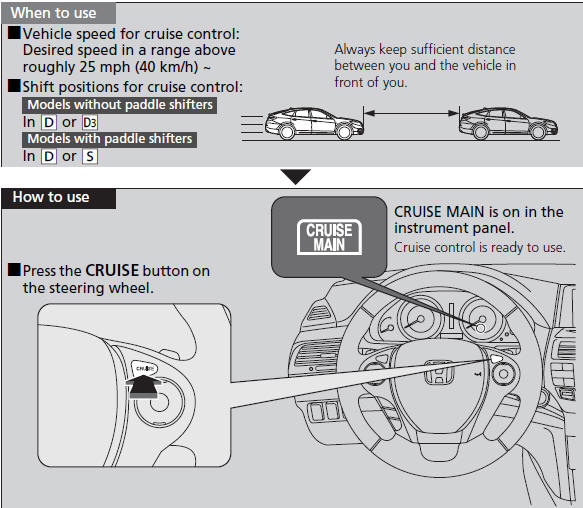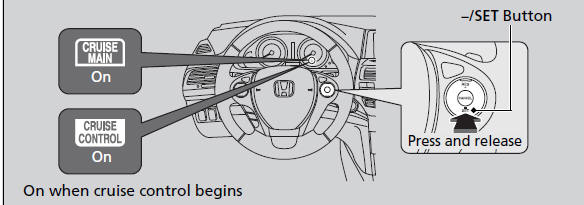Cruise Control
Maintains a constant vehicle speed without having to keep your foot on the accelerator. Use cruise control on freeways or open roads where you can travel at a constant speed with little acceleration or deceleration.

WARNING
Improper use of the cruise control can lead to a crash.
Use the cruise control only when traveling on open highways in good weather.
It may not be possible to maintain a constant speed when driving uphill or downhill.
When not using cruise control: Turn off cruise control by pressing the CRUISE button.
■To Set the Vehicle Speed

Take your foot off the pedal and press the –/SET button when you reach the desired speed.
The moment you release the –/SET button, the set speed is fixed, and cruise control begins. The CRUISE CONTROL indicator comes on.
■To Adjust the Vehicle Speed
Increase or decrease the vehicle speed using the RES/+ or –/SET buttons on the steering wheel.

• Each time you press the button, the vehicle speed is increased or decreased
by
about 1 mph (1.6 km/h).
• If you keep the button pressed, the vehicle speed increases or decreases until
you
release it. This speed is then set.
You can set the vehicle speed using the –/SET button on the steering wheel when adjusting the speed with the accelerator and brake pedals.
■To Cancel

To cancel cruise control, do any of the following:
• Press the CANCEL button.
• Press the CRUISE button.
• Depress the brake pedal.
The CRUISE CONTROL indicator goes off.
Resuming the prior set speed: After cruise control has been canceled, you can still resume the prior set speed by pressing the RES/+ button while driving at a speed of at least 25 mph (40 km/h) or more.
You cannot set or resume in the following situations:
• When vehicle speed is less than 25 mph (40 km/h)
• When the CRUISE button is turned off
At vehicle speeds of 22 mph (35 km/h) or less, cruise control is canceled automatically.
See also:
Changing the Engine Oil and Filter
Always change the oil and filter according to the maintenance messages shown
on the information display. The oil and filter collect contaminants that can damage
your engine if they are not removed ...
Automatic Seat Belt Tensioners
The front seats are equipped with automatic seat belt tensioners to enhance safety.
The tensioners automatically tighten the front seat belts during a moderate-tosevere
frontal collision, sometimes ...
Information Display
The information display shows the odometer, trip meter, engine oil life and maintenance
service item codes, and other gauges.
Switching the Display
Press the (Select/Reset) knob to
change the dis ...






